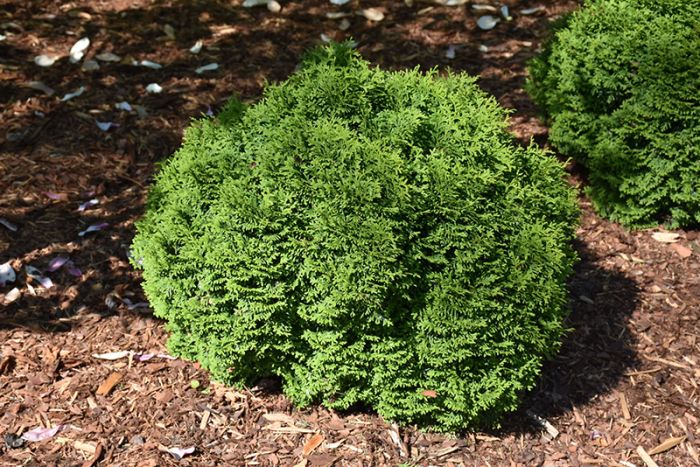Thuja, Arborvitae 'Tator Tot®'



- Sun Preference
- Full-Sun, Part-Sun
Description
A beautiful accent shrub for the garden with rich light to medium green foliage that turns a brownish bronze in winter, on a tiny ball-shaped form; best with some shelter in winter, captivating in a rock garden
Minnesota's Largest Selection of Shrubs
Elevate your landscaping with Gertens' unmatched variety of shrubs! Selecting the right shrubs for your backyard can enhance its beauty and functionality. Consider factors like sunlight, soil type, and mature size when choosing shrubs. For sunny areas, flowering shrubs like roses or hydrangeas can add color and charm. In shady spots, opt for shrubs like azaleas or hostas. Evergreen shrubs provide year-round interest and privacy, while deciduous shrubs offer seasonal color changes. At Gertens, we offer a wide selection of shrubs to suit every backyard need.
Details
Height: 18 inches
Spread: 24 inches
Sunlight: ![]()
![]()
Hardiness Zone: 2b
Other Names: Tiny Tot Arborvitae, Eastern White Cedar
Description:
A beautiful accent shrub for the garden with rich light to medium green foliage that turns a brownish bronze in winter, on a tiny ball-shaped form; best with some shelter in winter, captivating in a rock garden
Ornamental Features
Tater Tot® Arborvitae is a dwarf conifer which is primarily valued in the garden for its decidedly oval form. It has rich green evergreen foliage. The scale-like sprays of foliage turn coppery-bronze in the fall, which persists throughout the winter.
Landscape Attributes
Tater Tot® Arborvitae is a dense multi-stemmed evergreen shrub with a shapely oval form. It lends an extremely fine and delicate texture to the landscape composition which should be used to full effect.
This is a relatively low maintenance shrub. When pruning is necessary, it is recommended to only trim back the new growth of the current season, other than to remove any dieback. It has no significant negative characteristics.
Tater Tot® Arborvitae is recommended for the following landscape applications;
- Mass Planting
- Rock/Alpine Gardens
- General Garden Use
- Container Planting
Planting & Growing
Tater Tot® Arborvitae will grow to be about 18 inches tall at maturity, with a spread of 24 inches. It tends to fill out right to the ground and therefore doesn't necessarily require facer plants in front. It grows at a slow rate, and under ideal conditions can be expected to live for approximately 30 years.
This shrub does best in full sun to partial shade. It prefers to grow in average to moist conditions, and shouldn't be allowed to dry out. It is not particular as to soil type or pH. It is somewhat tolerant of urban pollution, and will benefit from being planted in a relatively sheltered location. Consider applying a thick mulch around the root zone in winter to protect it in exposed locations or colder microclimates. This is a selection of a native North American species.
Tater Tot® Arborvitae makes a fine choice for the outdoor landscape, but it is also well-suited for use in outdoor pots and containers. It is often used as a 'filler' in the 'spiller-thriller-filler' container combination, providing the canvas against which the thriller plants stand out. Note that when grown in a container, it may not perform exactly as indicated on the tag - this is to be expected. Also note that when growing plants in outdoor containers and baskets, they may require more frequent waterings than they would in the yard or garden. Be aware that in our climate, most plants cannot be expected to survive the winter if left in containers outdoors, and this plant is no exception. Contact our experts for more information on how to protect it over the winter months.
| SKU | Container Size |
| E3546 | #2 Container |
* Not all container sizes may be available at this time. See store for details on specific container size availability.
More Information
| Gerten Grown Plants | Gerten Grown Plants |
|---|---|
| Sun Preference | Full-Sun, Part-Sun |
| Mature Height (Range) | under 2 feet |
| USDA Hardiness Zone | 3, 4, 5, 6, 7, 8 |
| Common Family Name | Arborvitae |


